| Karkee Web Home Page | Officer's Main Page | W.E.O. Main Page | W.E.I.O. Main Page |
Web Equipment, Infantry Officers
Haversacks & Packs
As with the 1916 pattern, the weave pattern of Mills Equipment for Officers was fine, involving singled warp threads, rather than the usual doubled threads.
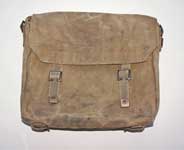

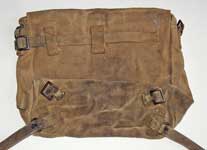 This was a new design, modelled after the Patt. ’19 W.E. version. Measuring 11 ¼ by 9-inches, its wedge section tapered from 2-inches at the mouth, to 4-inches at its base. The same ¾-inch transverse strap was fitted to its upper rear edge, buckling at the left of the rear face. This was threaded through vertical loops, stitched centrally and at the left, which formed two “loops” for the Braces to pass through, when it was worn on the back. The base had the same inclined buckles and web loops, which gave a storage location when the Straps, haversack were not in use. The flap fastened with a pair of ¾-inch straps and gated buckles, with small extensions of the sides into weather flaps underneath. KW have not yet located a properly marked example of the 1st issue Haversack for Web Equipment, Infantry Officers. However, if what we understand is correct, it should be identical to the 1st issue Haversack for W.E. Patt. '19. The Haversack shown here is the same one we show in that section. Maker marked "M.E. Co." and dated 1920, it is from the John Lamont Collection. Photographs © John Lamont 2010.
This was a new design, modelled after the Patt. ’19 W.E. version. Measuring 11 ¼ by 9-inches, its wedge section tapered from 2-inches at the mouth, to 4-inches at its base. The same ¾-inch transverse strap was fitted to its upper rear edge, buckling at the left of the rear face. This was threaded through vertical loops, stitched centrally and at the left, which formed two “loops” for the Braces to pass through, when it was worn on the back. The base had the same inclined buckles and web loops, which gave a storage location when the Straps, haversack were not in use. The flap fastened with a pair of ¾-inch straps and gated buckles, with small extensions of the sides into weather flaps underneath. KW have not yet located a properly marked example of the 1st issue Haversack for Web Equipment, Infantry Officers. However, if what we understand is correct, it should be identical to the 1st issue Haversack for W.E. Patt. '19. The Haversack shown here is the same one we show in that section. Maker marked "M.E. Co." and dated 1920, it is from the John Lamont Collection. Photographs © John Lamont 2010.
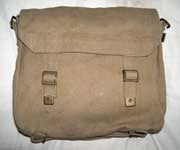
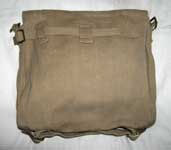 L of C §23970, approved 11th March 1921, for Patt. ’19 Haversacks, changed the gated buckle (or open-bar in the L of C) to a full 3-bar buckle. It is reasonable to assume this change was also mirrored as a 2nd Issue in the W.E.I.O. version. This 2nd issue Haversack is maker marked "M.E. Co." and dated 1938. From the Chris Pollendine Collection. Photographs © Chris Pollendine 2010.
L of C §23970, approved 11th March 1921, for Patt. ’19 Haversacks, changed the gated buckle (or open-bar in the L of C) to a full 3-bar buckle. It is reasonable to assume this change was also mirrored as a 2nd Issue in the W.E.I.O. version. This 2nd issue Haversack is maker marked "M.E. Co." and dated 1938. From the Chris Pollendine Collection. Photographs © Chris Pollendine 2010.
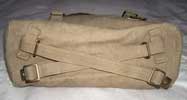
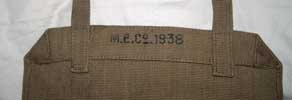 Details of the 2nd issue Haversack shown above. The photo far left shows the bottom, with its Haversack straps in place.
Details of the 2nd issue Haversack shown above. The photo far left shows the bottom, with its Haversack straps in place.
PACK (actually Rucksack), 1st Issue
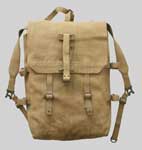
 In that the Pack had independent support from shoulder straps, it is a Rucksack, in strict terms. This was a design first used for a Portuguese Navy / Marine pattern, m/914 – note the omission of 1,000 years!. It is better known in Belgian M-1915 W.E., the 1916 Web Equipment, Officers, Experimental (W.E.,O.,X. – KW “shorthand”),the envelope being identical and the design was then carried over into Patt. ’19 W.E. as well. Taller and less wide than a Patt. ’08 Pack, it measured 14 ½-inches high, by 10-inches wide with sides 4 ½-inches wide. Adjustable, reduction-woven shoulder straps were set behind a broad, transverse reinforcing strip, stitched across the top of the rear face. These comprised the shoulder strap, superimposed on a chape with 2 inch buckle, the shoulder strap passing through the buckle. Adjustment was achieved by pulling a bight of the strap back through the buckle. The 1-inch sections were stitched to Hooks, haversack, left or right, which allowed connection to the loop, or 4th bar, of the Brace attachment.
In that the Pack had independent support from shoulder straps, it is a Rucksack, in strict terms. This was a design first used for a Portuguese Navy / Marine pattern, m/914 – note the omission of 1,000 years!. It is better known in Belgian M-1915 W.E., the 1916 Web Equipment, Officers, Experimental (W.E.,O.,X. – KW “shorthand”),the envelope being identical and the design was then carried over into Patt. ’19 W.E. as well. Taller and less wide than a Patt. ’08 Pack, it measured 14 ½-inches high, by 10-inches wide with sides 4 ½-inches wide. Adjustable, reduction-woven shoulder straps were set behind a broad, transverse reinforcing strip, stitched across the top of the rear face. These comprised the shoulder strap, superimposed on a chape with 2 inch buckle, the shoulder strap passing through the buckle. Adjustment was achieved by pulling a bight of the strap back through the buckle. The 1-inch sections were stitched to Hooks, haversack, left or right, which allowed connection to the loop, or 4th bar, of the Brace attachment.
This example of a 1st Issue Rucksack confirms that it is identical to the 1914 Portuguese and 1916 version of W.E., O., X. and is equipped with the loose, Strap, mess tin, that differentiates the officer’s version from Patt. ’19, which had a fixed strap, together with being a fine weave, with single warp threads, not the double ones of “standard” webbing. Buckles are “gated” – though Mills used the term “…mutilated…” back in 1912.
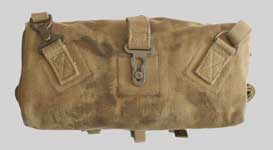 Eyes at the side of the Hooks carried ¾-inch counter straps, which attach to the base of the Pack. The left-hand counter strap was adjustable, via a brass buckle and was fixed to a brass dee on the base. The right-hand had a brass dee, on an adjustable strap, which attached to a hook on the Pack base. The final refinement was a Keyway, brass (termed a slotted buckle in L of C §23254) on a strap, stitched centrally at the lower rear face. This encircled the Belt, from the inside and was attached to a stud riveted into the base.
Eyes at the side of the Hooks carried ¾-inch counter straps, which attach to the base of the Pack. The left-hand counter strap was adjustable, via a brass buckle and was fixed to a brass dee on the base. The right-hand had a brass dee, on an adjustable strap, which attached to a hook on the Pack base. The final refinement was a Keyway, brass (termed a slotted buckle in L of C §23254) on a strap, stitched centrally at the lower rear face. This encircled the Belt, from the inside and was attached to a stud riveted into the base.
 Each side had a pair of blanket straps, ¾-inch wide, with a fifth strap on the top, allowing carriage of Great Coat, Ground Sheet, etc in a horseshoe roll. The front face of the flap, which closed with ¾-inch straps, not 1-inch, had two transverse loops of 1-inch strap accommodation, for a ¾ x 22-inch webbing Mess tin strap. This was the difference between it and the Patt. ’19 W.E. Pack, which had its 1-inch strap stitched directly to the flap. L of C §23970, approved 11th March 1921, for the Patt. ’19 Pack and Haversack, changed the ¾-inch buckles from the gated type to a full 3-bar buckle. This affected the flap buckles and the blanket straps. Theoretically, as with the Patt. ’19 Haversack, Mills ought to have modified the W.E., I.O. version, to maintain commonality in production.
Each side had a pair of blanket straps, ¾-inch wide, with a fifth strap on the top, allowing carriage of Great Coat, Ground Sheet, etc in a horseshoe roll. The front face of the flap, which closed with ¾-inch straps, not 1-inch, had two transverse loops of 1-inch strap accommodation, for a ¾ x 22-inch webbing Mess tin strap. This was the difference between it and the Patt. ’19 W.E. Pack, which had its 1-inch strap stitched directly to the flap. L of C §23970, approved 11th March 1921, for the Patt. ’19 Pack and Haversack, changed the ¾-inch buckles from the gated type to a full 3-bar buckle. This affected the flap buckles and the blanket straps. Theoretically, as with the Patt. ’19 Haversack, Mills ought to have modified the W.E., I.O. version, to maintain commonality in production.
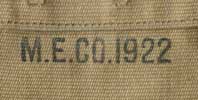 The Pack shown here is maker marked "M.E. Co." and dated 1922. However, the changed buckles had still not been reflected into this example. From the John Bodsworth Collection. Photographs © John Bodsworth, 2016.
The Pack shown here is maker marked "M.E. Co." and dated 1922. However, the changed buckles had still not been reflected into this example. From the John Bodsworth Collection. Photographs © John Bodsworth, 2016.
PACK (actually Rucksack), 2nd Issue
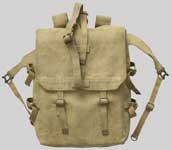
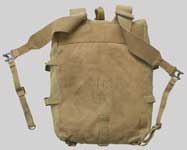
 The sole difference between 1st and 2nd Issues was the change to the full 3-bar ¾ inch buckles.
The sole difference between 1st and 2nd Issues was the change to the full 3-bar ¾ inch buckles.
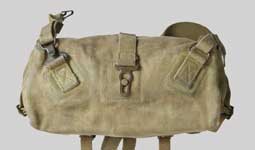 This example is marked on the back “KIMB 1/RS”, assumed to be the initials (rather than “Kim B”) of an unknown officer in 1st Royal Scots. This example was made by M.E.Co. and is dated 1930.
This example is marked on the back “KIMB 1/RS”, assumed to be the initials (rather than “Kim B”) of an unknown officer in 1st Royal Scots. This example was made by M.E.Co. and is dated 1930.
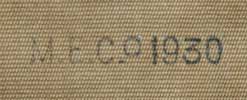 From the John Bodsworth Collection. Photographs © John Bodsworth, 2016.
From the John Bodsworth Collection. Photographs © John Bodsworth, 2016.
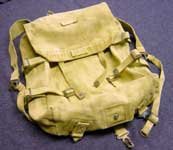
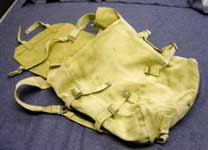
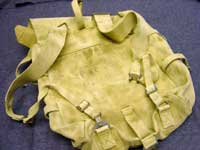 Another example of a 2nd Issue Rucksack, this one maker marked "M.E. Co.", dated 1934, and marked to a Kirby in the Durham Light Infantry.
Another example of a 2nd Issue Rucksack, this one maker marked "M.E. Co.", dated 1934, and marked to a Kirby in the Durham Light Infantry.
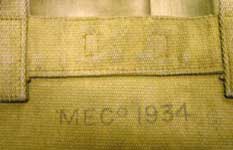 Marking detail of the 2nd issue W.E.I.O. Pack shown above.
Marking detail of the 2nd issue W.E.I.O. Pack shown above.